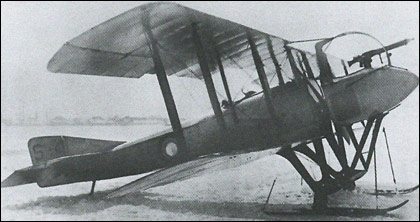|
| There is no text information for this aircraft at the moment.
| GrahamClayton, e-mail, 25.04.2023 08:03 The Royal Aircraft Factory in the UK built the experimental B.E.9 with the same layout, but thankfully it never went into production. reply | | Klaatu83, e-mail, 02.10.2015 07:35 There was one other variant of the famous SPAD fighter that is worthy of note. That was the SPAD XII, which was similar to the SPAD VII apart from the armament and control system. Instead of a synchronized machine gun, The SPAD XII was armed with a single 37-mm cannon which was arranged to fire through the hollow propeller-shaft of the engine. Since it was a single-shot gun and the breech intruded into the cockpit, the SPAD XII was fitted with Deperdussin-type controls in place of the conventional control column, which meant that a small control wheel was mounted on each side of the cockpit. The unusual control system, combined with the necessity to re-load the cannon manually after each shot, meant that the SPAD XII was only suitable for expert pilots. As a result only a few SPAD XII fighters were ever manufactured, but they were issued to some of the top French fighter aces, including Georges Guynemer. reply | | Klaatu83, e-mail, 02.10.2015 07:18 The SA.2 shown in the photo, mounted on skis, is one of the 57 examples of this aircraft that were supplied to the Russian Air Service. Only about 100 of these airplanes were ever built, compared with over 14,000 of the far-more successful SPAD VII and SPAD XIII fighters that were developed later in WW-I. reply | | Klaatu83, e-mail, 02.10.2015 07:13 This dreadful airplane represented an early attempt to provide a combat plane with a forward-firing machine-gun during the period before synchronizing gears became available. In this case it was done by placing a machine-gunner in a separate pulpit mounted in front of the engine, supported by a set of struts attached to the wings and landing gear. Since the pilot was seated behind the engine and wings, the pilot and gunner were unable to communicate with each other while in the air. In addition, if the plane nosed over on landing the gunner was a goner. Needless to say, it was not popular with the French Air Service. However, some were exported to Russia, where airmen apparently weren't so particular. Although operationally the SPAD SA.2 was a failure, the basic airframe was intrinsically sound. In 1916 SPAD re-designed the plane as a single-seat fighter without the gunner's pulpit, installed a synchronized forward-firing machine-gun and the new 150-hp Hispano-Suiza liquid-cooled V-8 engine. The result was the SPAD VII, which proved to be one of the best fighter planes of WW-I. In 1917 the already-good fighter was improved with the installation of the more powerful 200-hp version of the Hispano-Suiza engine and two machine guns, resulting in the excellent SPAD XIII. Over 14,000 SPAD VII and XIII fighters were built. reply | |
| | Adolf Jaeger, 27.01.2011 20:10 SPAD - Societe Pour les Appareils Deperdussin; later, after the Bleriot take-over, Societe Pour l'Aviation et ses Derives. reply | | Skyhogg, e-mail, 16.12.2010 11:52 I thought Rickenbacker used a S.P.A.D. XIII. reply | | Joe Jones, e-mail, 28.11.2010 23:47 I was hoping for the SPAD VIII that Eddie Rickenbacker flew when he became the top US Ace during WW1. reply | | leo rudnicki, e-mail, 30.04.2009 04:58 If you're the gunner and the pilot asks if you got any Beemans, just say no. reply | | Guilherme Loureiro, 02.08.2008 01:25 The SPADs you're thinking of are later models. This was the first SPAD model that saw combat reply | | Fred Henning, e-mail, 14.05.2008 05:28 Wasn't the SPAD a pursuit plane? It had a single cockpit and no bow gun as shown in the photo. reply |
|
Do you have any comments?
|
| |









